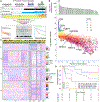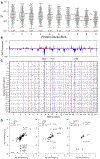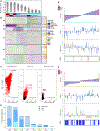The Proteogenomic Landscape of Curable Prostate Cancer
- PMID: 30889379
- PMCID: PMC6511374
- DOI: 10.1016/j.ccell.2019.02.005
The Proteogenomic Landscape of Curable Prostate Cancer
Abstract
DNA sequencing has identified recurrent mutations that drive the aggressiveness of prostate cancers. Surprisingly, the influence of genomic, epigenomic, and transcriptomic dysregulation on the tumor proteome remains poorly understood. We profiled the genomes, epigenomes, transcriptomes, and proteomes of 76 localized, intermediate-risk prostate cancers. We discovered that the genomic subtypes of prostate cancer converge on five proteomic subtypes, with distinct clinical trajectories. ETS fusions, the most common alteration in prostate tumors, affect different genes and pathways in the proteome and transcriptome. Globally, mRNA abundance changes explain only ∼10% of protein abundance variability. As a result, prognostic biomarkers combining genomic or epigenomic features with proteomic ones significantly outperform biomarkers comprised of a single data type.
Keywords: biomarker; epigenome; genome; multi-omic features; prostate cancer; proteome; transcriptome.
Copyright © 2019 Elsevier Inc. All rights reserved.
Conflict of interest statement
Declaration of Interest
All authors declare that they have no conflicts of interest.
Figures





Comment in
-
Re: The Proteogenomic Landscape of Curable Prostate Cancer.J Urol. 2019 Oct;202(4):664. doi: 10.1097/01.JU.0000576980.13730.fe. Epub 2019 Sep 6. J Urol. 2019. PMID: 31287765 No abstract available.
References
-
- Blume-Jensen P, Berman DM, Rimm DL, Shipitsin M, Putzi M, Nifong TP, Small C, Choudhury S, Capela T, Coupal L, et al. (2015). Development and Clinical Validation of an In Situ Biopsy-Based Multimarker Assay for Risk Stratification in Prostate Cancer. Clin. Cancer Res. 21, 2591–2600. - PubMed
Publication types
MeSH terms
Substances
Grants and funding
LinkOut - more resources
Full Text Sources
Other Literature Sources
Medical
Molecular Biology Databases
Research Materials

